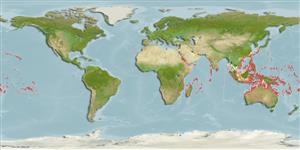Actinoptérygiens (poissons à nageoires rayonnées) >
Perciformes (Perch-likes) >
Scaridae (Parrotfishes) > Scarinae
Etymology: Cetoscarus: Greek, ketos = a marine monster, whale + Greek, skaros = a fish cited by ancient writers; a parrot fish (Ref. 45335).
Issue
This species is endemic to the Red Sea (Ref. 54980:447, species treatment in prep). Correction of data in progress (information transfer to C. ocellatus of the Indo-Pacific).
Environnement / Climat / Gamme
Écologie
; marin récifal; profondeur 1 - 30 m (Ref. 9710), usually 1 - 30 m (Ref. 27115). Tropical; 24°C - 28°C (Ref. 27115), preferred ?; 33°N - 25°S, 34°E - 134°W
Indo-Pacific: including the Red Sea.
Length at first maturity / Taille / Poids / Âge
Maturity: Lm 30.0 range ? - ? cm
Max length : 90.0 cm TL mâle / non sexé; (Ref. 2871)
Épines dorsales (Total): 9; Rayons mous dorsaux (Total): 10; Épines anales 3; Rayons mous anaux: 9
Occurs in clear lagoon and seaward reefs (Ref. 1602). Juveniles usually solitary; adults form harems (Ref. 9710); males are territorial. Goes to several changes during growth and very large females change sex to the brightly colored male. Small juveniles usually in dense coral and algae habitats (Ref. 48636). Benthic grazer of algae (Ref. 3488). Caught with nets and other types of artisanal gear.
Life cycle and mating behavior
Maturité | Reproduction | Frai | Œufs | Fécondité | Larves
Oviparous, distinct pairing during breeding (Ref. 205).
Randall, J.E., G.R. Allen and R.C. Steene, 1990. Fishes of the Great Barrier Reef and Coral Sea. University of Hawaii Press, Honolulu, Hawaii. 506 p. (Ref. 2334)
Statut dans la liste rouge de l'IUCN (Ref. 115185)
CITES (Ref. 94142)
Not Evaluated
Menace pour l'homme
Harmless
Utilisations par l'homme
Pêcheries: commercial; Aquarium: Commercial
Plus d'informations
RéférencesAquacultureProfil d'aquacultureSouchesGénétiqueFréquences alléliquesHéritabilitéPathologiesTraitementMass conversion
Outils
Articles particuliers
Télécharger en XML
Sources Internet
